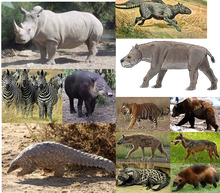| Pegasoferae Temporal range: early Paleocene to present | |
|---|---|

| |

| |
| Scientific classification | |
| Domain: | Eukaryota |
| Kingdom: | Animalia |
| Phylum: | Chordata |
| Class: | Mammalia |
| Superorder: | Laurasiatheria |
| Clade: | Scrotifera |
| Clade: | Pegasoferae Nishihara, 2006 |
| Subgroups | |
| |
Pegasoferae ("winged beast") is a proposed clade of mammals based on genomic research in molecular systematics by Nishihara, Hasegawa and Okada (2006).
To the surprise of the authors, their data led them to propose a clade that includes bats (order Chiroptera), carnivores such as cats and dogs (order Carnivora), horses and other odd-toed ungulates (order Perissodactyla) and pangolins (order Pholidota) as springing from a single evolutionary origin within the mammals.
The name Pegasoferae was coined from the name of the mythological flying horse Pegasus to refer to bats and horses, and the term Ferae, encompassing carnivorans and pangolins. According to this, the odd-toed ungulates' closest living relatives are the carnivorans. Earlier theories of mammalian evolution would, for example, have aligned bats with the insectivores (order Eulipotyphla) and horses with the even-toed ungulates (order Artiodactyla).
Some subsequent molecular studies published shortly afterwards have failed to support it. In particular, two recent studies, each combining genome-wide analyses of multiple taxa with testing of competing alternative phylogenetic hypotheses, concluded that Pegasoferae is not a natural grouping.
Phylogeny
The following cladogram shows the phylogenetic relationships of laurasiatherian mammals following Nishihara et al. (2006).
| Laurasiatheria |
| ||||||||||||||||||||||||
References
- ^ Nishihara, H.; Hasegawa, M.; Okada, N. (2006). "Pegasoferae, an unexpected mammalian clade revealed by tracking ancient retroposon insertions". Proceedings of the National Academy of Sciences of the United States of America. 103 (26): 9929–9934. doi:10.1073/pnas.0603797103. PMC 1479866. PMID 16785431.
- Matthee, Conrad A.; Eick, Geeta; Willows-Munro, Sandi; Montgelard, Claudine; Pardini, Amanda T.; Robinson, Terence J. (2007). "Indel evolution of mammalian introns and the utility of non-coding nuclear markers in eutherian phylogenetics". Molecular Phylogenetics and Evolution. 42 (3): 827–837. doi:10.1016/j.ympev.2006.10.002. PMID 17101283.
- Springer, M.S.; Burk-Herrick, A.; Meredith, R.; Eizirik, E.; Teeling, E.; O'Brien, S.J.; Murphy, W.J. (2007). "The adequacy of morphology for reconstructing the early history of placental mammals". Systematic Biology. 56 (4): 673–684. doi:10.1080/10635150701491149. PMID 17661234.
- Kitazoe, Yasuhiro; Kishino, Hirohisa; Waddell, Peter J.; Nakajima, Noriaki; Okabayashi, Takahisa; Watabe, Teruaki; Okuhara, Yoshiyasu (2007). Hahn, Matthew (ed.). "Robust Time Estimation Reconciles Views of the Antiquity of Placental Mammals". PLOS ONE. 2 (4): e384. doi:10.1371/journal.pone.0000384. PMC 1849890. PMID 17440620.
- Zhou, Xuming; Xu, Shixia; Xu, Junxiao; Chen, Bingyao; Zhou, Kaiya; Yang, Guang (2011). "Phylogenomic Analysis Resolves the Interordinal Relationships and Rapid Diversification of the Laurasiatherian Mammals". Systematic Biology. 61 (1): 150–164. doi:10.1093/sysbio/syr089. PMC 3243735. PMID 21900649.
- Tsagkogeorga, G; Parker, J; Stupka, E; Cotton, JA; Rossiter, SJ (2013). "Phylogenomic analyses elucidate the evolutionary relationships of bats (Chiroptera)" (PDF). Current Biology. 23 (22): 2262–2267. doi:10.1016/j.cub.2013.09.014. PMID 24184098.